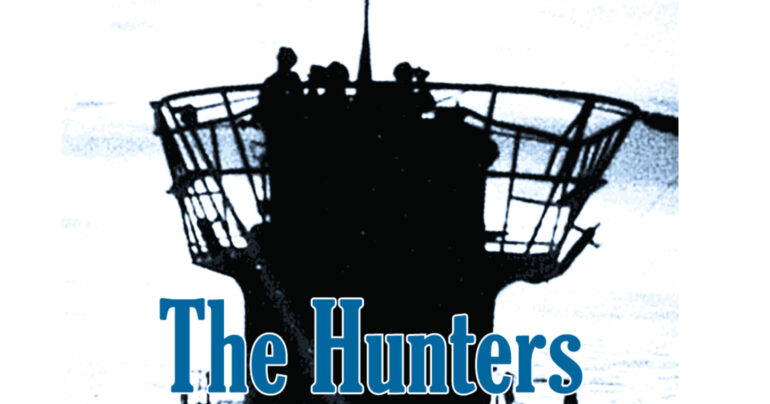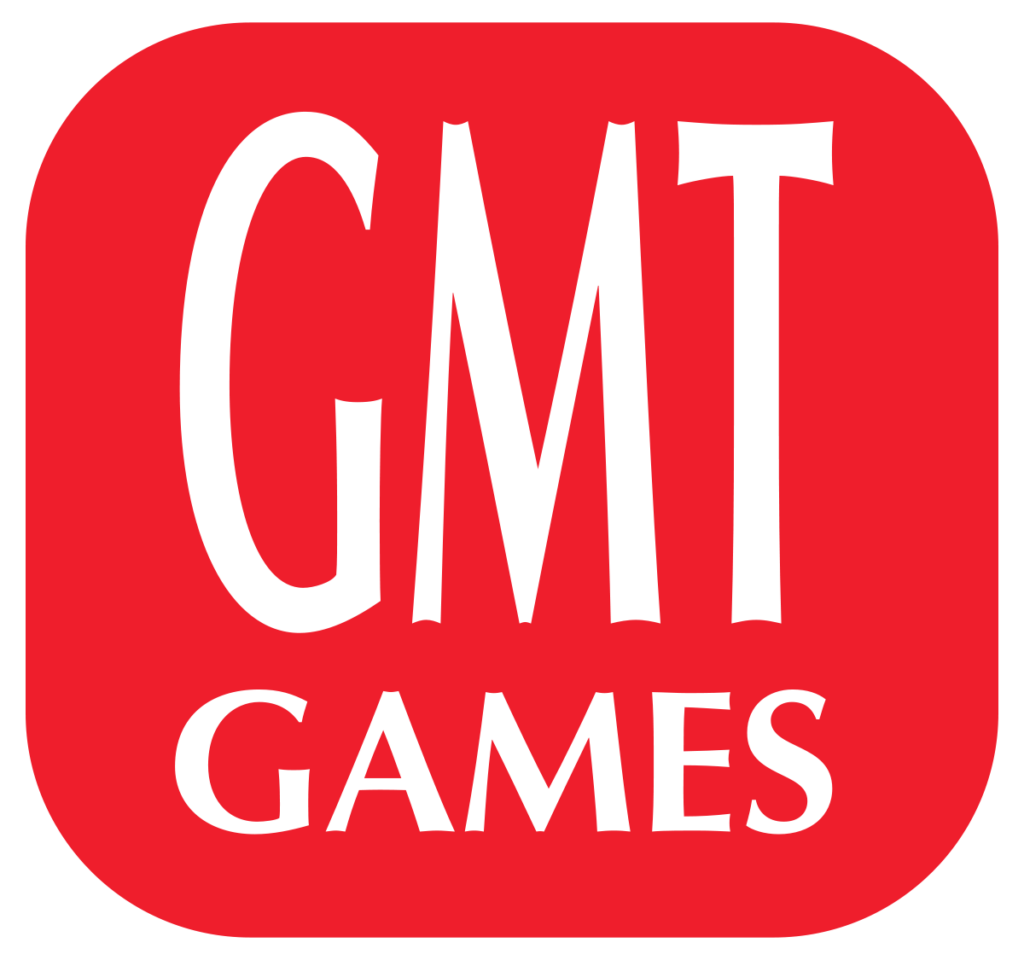
The Boat Is Rated To 90 Metres, But Of Course We Can Go Deeper.
2nd Lieutenant (Das Boot)
Designed by Gregory M. Smith and published by Consim Press and distributed by GMT Games. I bought a copy of The Hunters on a whim back in 2013 during the later days of my wife’s pregnancy. I was starting to feel my gaming opportunities slip away, so solo gaming was a thing I began investigating. Nevertheless, The Hunters sat on my shelf for a couple of years before I finally tore off the shrink wrap and dove in (or under).
When opening up the box, my initial impression was that this didn’t look exactly like a wargame. There is no board or map in the box. There is a 24 page rulebook, some player boards that track the status of your U-boat (double-sided boards for different U-boat models), and about three double-sided charts that contain tables for you to roll against when performing actions and looking up results. There are also a variety of very nice counters to track torpedos, deck gun ammunition, damage, crew status, targets and escorts, etc, and a half dozen dice. It almost looks… like a roleplaying game.
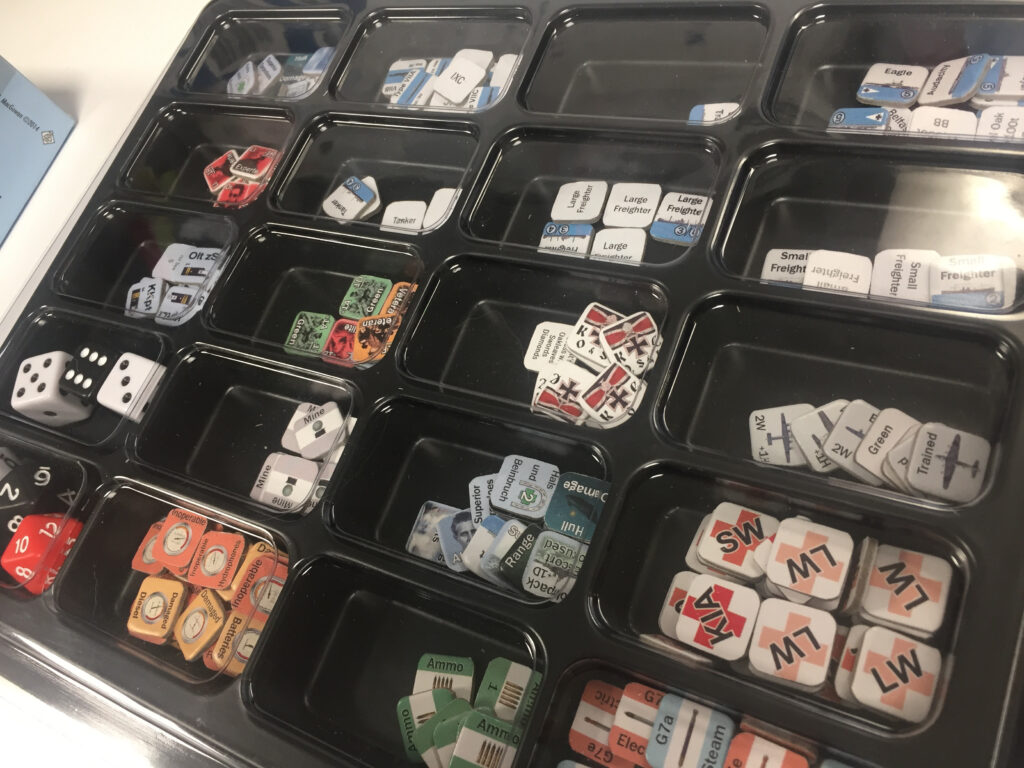
That’s not entirely surprising, because a lot of the action in The Hunters will play out inside your head. Players will pick a starting sub/year, and outfit their boat with all it’s accoutrements before rolling the dice to head out to sea. The initial setup for the game was surprisingly simple and logical. When you receive orders for the location of your patrol, this is managed on a Patrol Location chart… which will order you into the North Atlantic, around the British Isles, or off the coast of Spain. Later era patrols will have you venturing toward North American shores, or into the Caribbean.
Now your patrol begins in earnest. Mechanically speaking, you will be moving your U-boat token through a swimlane that depicts the steps of your patrol, with each box representing three or four days of your patrol. Therefore, most patrols from start to finish typically last about a month, with longer range patrols (ie. North America) taking a bit more time. At each step on these swimlanes, you’ll roll to check for an encounter. In some steps, you may roll twice, if it’s a particularly active area of the ocean.
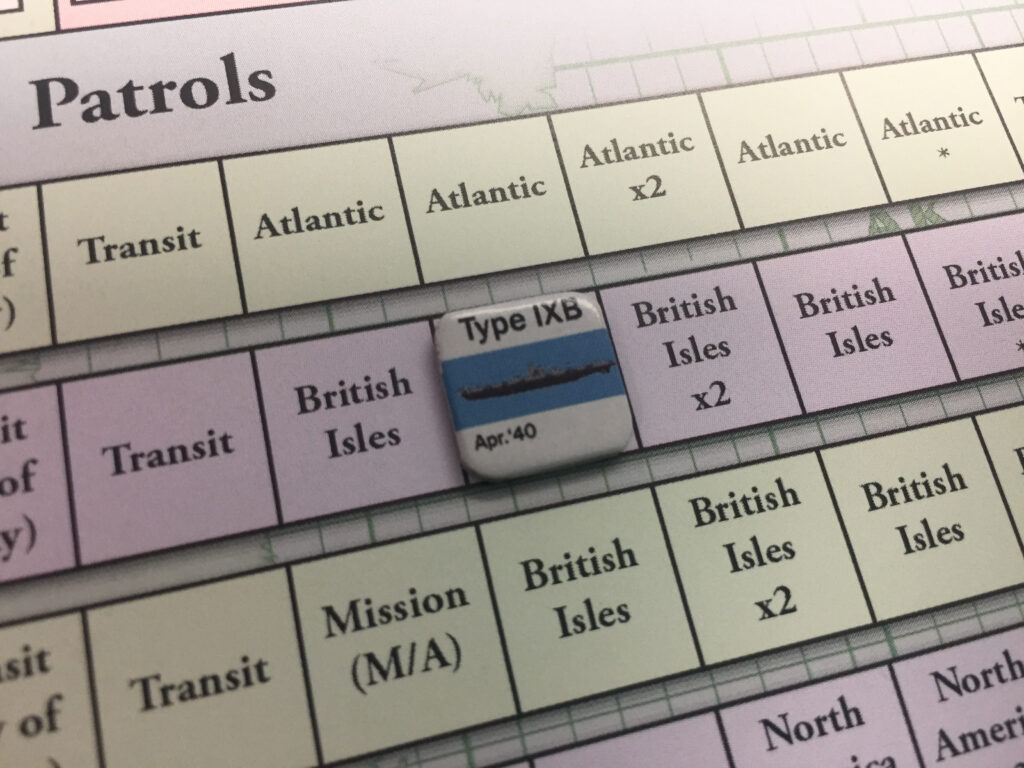
If you roll an encounter in a patrol box, it will come in one of a variety of forms. It could be an aircraft encounter, which are more common in transit boxes (near land), and always dangerous. If you’re lucky, it could be a single unescorted ship. Easy target, and you could potentially use your deck guns! If it’s a ship with an escort, however, you’ll need to attack it from a submerged position, or maybe follow it around until night to try a surface attack.
Once you determine if you’ve come upon a ship or convoy, you’ll roll to determine the type and size (tonnage) of those vessels. They could be small freighters, large freighters, tankers, or capital ships. Bigger ships are harder to sink, so need to be hit more times to induce more damage. You’ll do this primarily with torpedoes. Steam torpedoes are more reliable, but easier to spot in the daytime thanks to a trail of bubbles. Electric G7e’s are sneakier, but harder to maintain in good working order – resulting in more duds. Pick your salvo, assign them targets, and fire away!
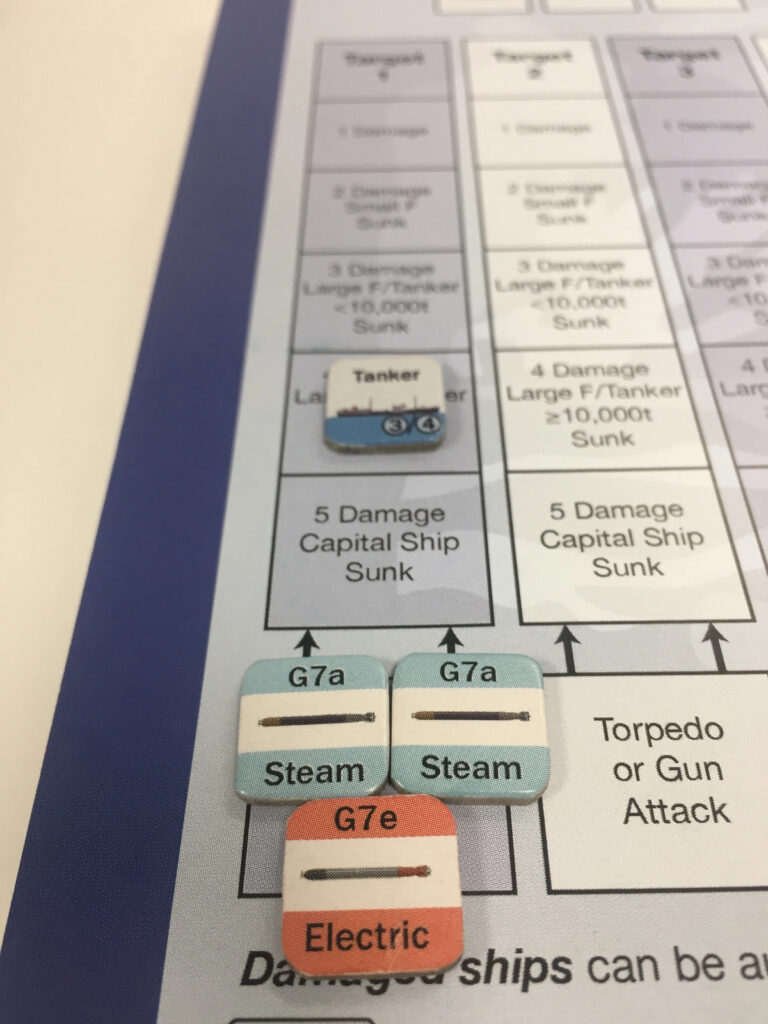
Combat is streamlined in The Hunters. You’re essentially picking a range, checking against a list of possible die roll modifiers (things like time of day, whether your crew is better trained, if you’re firing steam or electric torpedoes, whether you have upgraded torpedoes, etc), and then rolling. Hits (from torpedoes) are then checked for duds. If it’s a good torpedo, you roll for damage, and hope you sunk her. If you did, you’ll record that success in your logbook.
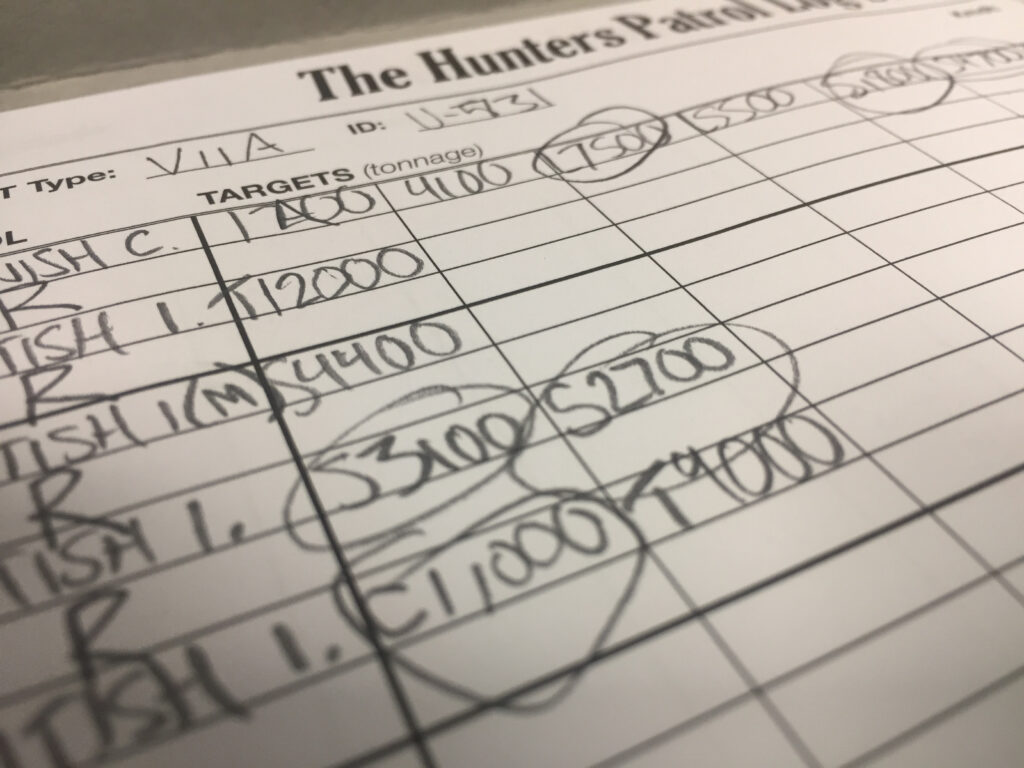
If you didn’t, you’ll have the chance to try and force an additional combat action, or if escorted, following the damaged ship or the remainder of the convoy. Either way, if there was an escort, it’s here that you’ll check for detection. You may crash dive and avoid being noticed, but if that doesn’t work – this is where things can get really hairy.
A detected sub will take a certain number of hits against various systems, possibly damaging or destroying those systems. They could also potentially cause flooding, or even crew injury, or death. Once you absorb this damage, you continue the game of cat and mouse, and hope to slip away from the escort.
If you can, you’ll move on to the next patrol space and start all over, and if you can get all the way back through you transit zone and to your dock, it’s time to refit.
A refit is a period of time (at least one month) where damage to your ship is repaired, ammo and supplies are reloaded, and crew recovery, replacement, or promotions are handled. Depending on your success, and the amount of patrols you’ve completed, you may also be in line for a new boat. Aktualisierung!
A full game of The Hunters will have you going out on a number of patrols, leading up to or through the summer of 1943. At this point, the only thing that matters is the total tonnage of allied vessels you have personally been responsible for sinking to the bottom of the ocean. Anything less than 50,000 tonnes is a defeat, but there are various levels of success above and beyond this amount, so don’t get too cocky.
I have really enjoyed my plays of The Hunters. A couple of notes. First, while I would call this a tactical level game, this isn’t a simulation of U-boat combat. The designer has really abstracted and reduced the decision matrix to the necessary elements needed in order to evoke a certain feeling, but this plays out well in my estimation. I don’t feel like there’s anything missing in terms of detail, that would improve the game in any kind of meaningful way.
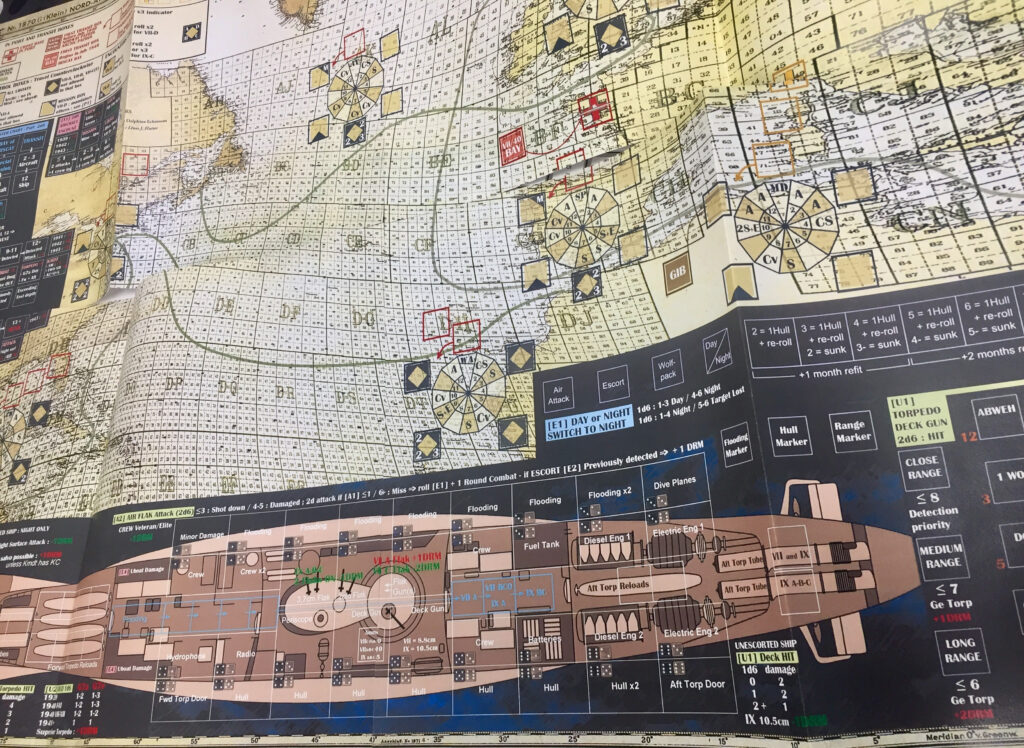
Having said that, I do feel like a couple components could have been added or altered that may have improved the overall experience here. The first is a board. By default, the game doesn’t play out in front of you as much as it does in your own head, similar to a roleplaying game, but that doesn’t need to be the case.
I’ve printed out the “huge map” from BGG user koinskyz, which fits on four A3 or Tabloid (11×17) size pieces of paper, creating a main playing surface of a little less than 22×34″. The style of the map is gorgeous and very evocative of the subject matter. It contains many of the charts you need to regularly reference, and also replaces the U-boat mat for tracking damage, ammunition, flooding, and crew.
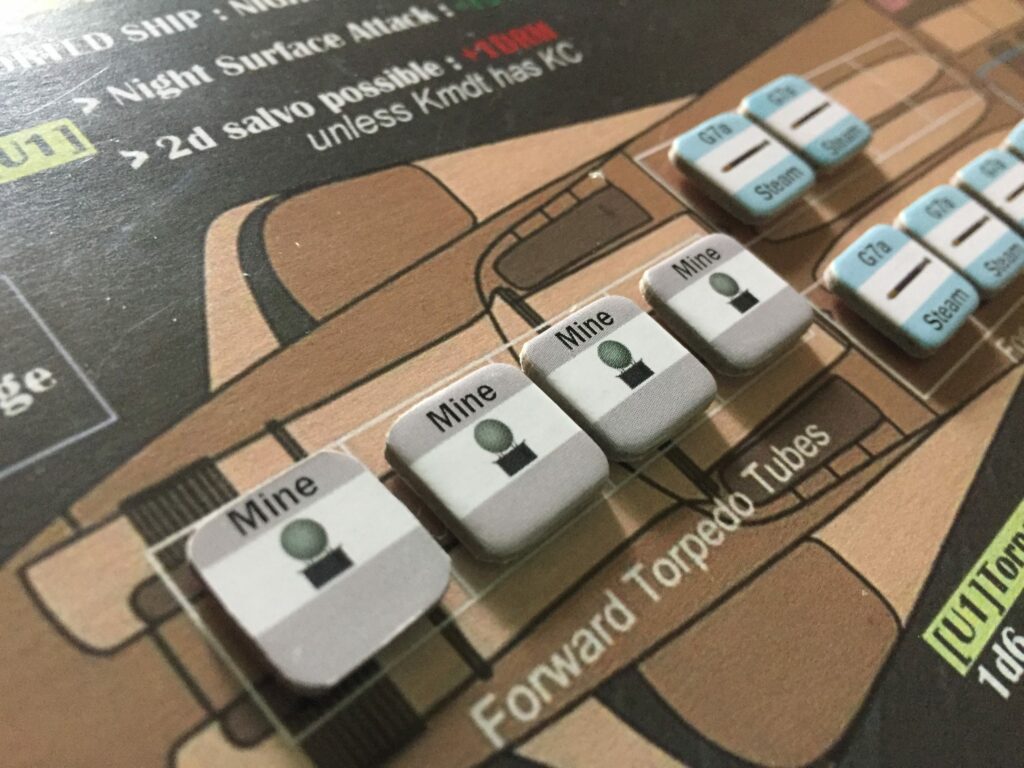
Additionally, the patrol spaces are now placed directly on the map, so it gives you more of a sense of sailing out to sea. There’s nothing quite like the feeling of loading up torpedos in actual little tube slots. It’s ridiculous, I know, but it’s fun. I’d highly recommend printing this out and sliding it under some plexiglass for anyone who owns the game.
The second change I would make to components is to remove the ship identification charts and replace them with ship cards. This would allow you to do a few things. First, it could show you an image of the ship in question, since all the ships on the chart are actual vessels sunk or attacked by axis U-boats. This would add a lot of flavour. It would eliminate the problem of rolling the same ship twice. It could allow you to track damage to that vessel right on the card, and be utilized as a keepsake or trophy if you sunk it, eliminating the need for a log. You may need to find another way to track refit times, but that should be fairly easy. The only problem with this approach is that there are hundreds of ships… and so would require hundreds of cards. Maybe not realistic… but it would be an amazing addition.
Regardless, the game manages to shine despite my small component quibbles. It’s a game I can set up and leave out for a few days as I knock off a couple of patrols every evening, since each patrol is a nicely encapsulated series of events. It’s filled with tense, meaningful decisions. Sometimes your plans are squashed by ill-fated die rolls, but I feel like this adds excitement to the game. Some of your patrols will be quiet, while others will have an arpeggio of cinematic moments that drag you through the story and keep you on your toes. For me, this is a sign of an excellent design.

